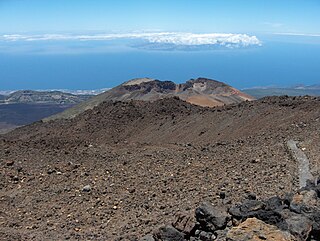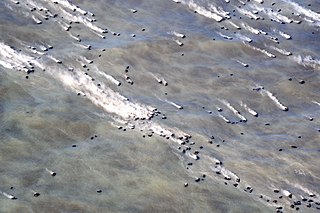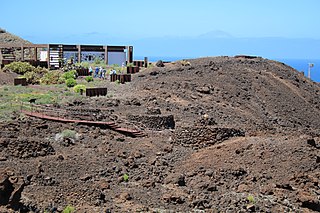
The Canary Islands, also known informally as the Canaries, are a Spanish autonomous community and archipelago in Macaronesia in the Atlantic Ocean. At their closest point to the African mainland, they are 100 kilometres west of Morocco and the Western Sahara. They are the southernmost of the autonomous communities of Spain. The islands have a population of 2.2 million people and are the most populous special territory of the European Union.

La Palma, also known as La isla bonita and historically San Miguel de La Palma, is the most northwesterly island of the Canary Islands, Spain. La Palma has an area of 708 square kilometres (273 sq mi) making it the fifth largest of the eight main Canary Islands. The total population at the end of 2020 was 85,840, of which 15,716 lived in the capital, Santa Cruz de La Palma and about 20,467 in Los Llanos de Aridane. Its highest mountain is the Roque de los Muchachos, at 2,426 metres (7,959 ft), being second among the peaks of the Canaries after the Teide massif on Tenerife.

El Hierro, nicknamed Isla del Meridiano, is the second-smallest and farthest-south and -west of the Canary Islands, in the Atlantic Ocean off the coast of Africa, with a population of 10,968 (2019). Its capital is Valverde. At 268.51 square kilometres (103.67 sq mi), it is the second-smallest of the eight main islands of the Canaries.

Lanzarote is a Spanish island, the easternmost of the Canary Islands in the Atlantic Ocean, 125 kilometres off the north coast of Africa and 1,000 kilometres from the Iberian Peninsula. Covering 845.94 square kilometres, Lanzarote is the fourth-largest of the islands in the archipelago. With 152,289 inhabitants at the start of 2019, it is the third most populous Canary Island, after Tenerife and Gran Canaria. Located in the centre-west of the island is Timanfaya National Park, one of its main attractions. The island was declared a biosphere reserve by UNESCO in 1993. The island's capital is Arrecife, which lies on the eastern coastline. It is the smaller main island of the Province of Las Palmas.

Teide, or Mount Teide, is a volcano on Tenerife in the Canary Islands, Spain. Its summit is the highest point in Spain and the highest point above sea level in the islands of the Atlantic. If measured from the ocean floor, its height of 7,500 m (24,600 ft) makes Teide the third-highest volcano in the world, and is described by UNESCO and NASA as Earth's third-tallest volcanic structure. Teide's elevation above sea level makes Tenerife the tenth highest island in the world.

The Cumbre Vieja is an active volcanic ridge on the island of La Palma in the Canary Islands, Spain. The spine of Cumbre Vieja trends in an approximate north–south direction, comprising the southern half of La Palma, with both summit ridge and flanks pockmarked by dozens of craters and cones. The latest eruption began on 19 September 2021 in a forested area of Las Manchas locality known as Cabeza de Vaca. Voluminous lava flows quickly reached populated areas downslope, fanning out across settlements and banana plantations, destroying thousands of buildings and ultimately pouring over steep cliffs into the ocean to enlarge the island at several locations. The volcano went quiet on 13 December 2021, and on 25 December 2021, the local government declared the eruption to be over.

Teneguía is a monogenetic cinder cone – a volcanic vent which has been active once and has had further seismic activity. It is situated on the island of La Palma, one of the Canary Islands, and is located at the southern end of the sub-aerial section of the Cumbre Vieja volcano, of which Teneguía is just one of several vents.

The Canary hotspot, also called the Canarian hotspot, is a hotspot and volcanically active region centred on the Canary Islands located off the north-western coast of Africa. Hypotheses for this volcanic activity include a deep mantle plume beginning about 70 million years ago. The underwater El Hierro and subaerial Cumbre Vieja eruptions remain the most recent Canarian eruptions.

Pico Viejo is a volcano located on the island of Tenerife in Canary Islands, Spain. It is the second highest peak of Tenerife and the Canary Islands, with a height of 3,135 m above sea level, and a huge crater approximately 720 metres in diameter.

The 2011–2012 El Hierro eruption occurred just off the island of El Hierro, the smallest and farthest south and west of the Canary Islands, in the Atlantic Ocean off the coast of Africa. The island is also the youngest in the volcanic chain. The October 2011 – March 2012 eruption was underwater, with a fissure of vents located approximately 2 kilometres to the south of the fishing village of La Restinga on the southern coast of the island. Increased seismicity in June 2012 to the north-west of the vent did not result in another phase of eruptive activity. Until the 2021 La Palma eruption, which started on 19 September 2021, this was the last volcanic eruption in Spain.

Tanganasoga is the main volcano of El Hierro's El Golfo area in the Canary Islands, consisting of a cinder cone. The volcano is part of a much larger shield volcano system.

The El Maipés necropolis is an ancient burial site near Agaete on the Spanish island of Grand Canary, province of Las Palmas in the Canary Islands of the west coast of Africa.

A lava balloon is a gas-filled bubble of lava that floats on the sea surface. It can be up to several metres in size. When it emerges from the sea, it is usually hot and often steaming. After floating for some time it fills with water and sinks again.

The Canary Islands Seamount Province (CISP) is located in the Atlantic Ocean between 23º and 33º north. It comprises the seven major islands of the Canary Islands archipelago, the two islets of the Savage Islands and 16 seamounts scattered along an area of 540,000 km2 parallel to the northwestern coastline of the African Continent. Besides its geographical distribution, the components of the province share a series of geochemical similarities.
The 1826 Canary Islands storm was the worst weather-related disaster in the history of the Canary Islands, claiming at least 298 lives. It was likely either a tropical cyclone or a storm system derived from a tropical cyclone.

The geology of the Canary Islands is dominated by volcanic rock. The Canary Islands and some seamounts to the north-east form the Canary Volcanic Province whose volcanic history started about 70 million years ago. The Canary Islands region is still volcanically active. The most recent volcanic eruption on land occurred in 2021 and the most recent underwater eruption was in 2011-12.

An eruption at the Cumbre Vieja volcanic ridge, comprising the southern half of the Spanish island of La Palma in the Canary Islands, took place between 19 September and 13 December 2021. It was the first volcanic eruption on the island since the eruption of Teneguía in 1971. At 85 days, it is the longest known and the most damaging volcanic eruption on La Palma since records began. The total damage caused by the volcano amounts up to 843 million euros.

Tajogaite or Tajogaite Volcano is a monogenetic volcano located in the municipality of El Paso on the island of La Palma, Canary Islands. It originated in the eruption that began on September 19, 2021, the most recent on the island and in the national terrestrial geography. It stopped on December 13, 2021, after 85 days of activity, being the longest historical eruption recorded on the island and third in the archipelago.

Montaña Blanca is a mountain on the Canary Island of Tenerife. Its flat summit on the eastern flank of the Pico del Teide above the edge mountains of the Las Cañadas basin at a height of 2,748 m (9,016 ft). This makes the Montaña Blanca the third highest peak in Tenerife after the Pico del Teide and the Pico Viejo.



















